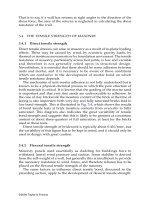DESIGN OF MASONRY STRUCTURES Part 5 potx
Bạn đang xem bản rút gọn của tài liệu. Xem và tải ngay bản đầy đủ của tài liệu tại đây (460.28 KB, 22 trang )
Note that some designers include the above modification factors in the
basic equation (5.11) where they appear as a multiplication factor on the
right-hand side, e.g. for narrow walls, equation (5.11) could be rewritten
5.9 EXAMPLES
5.9.1 Example 1: Internal masonry wall (Fig. 5.15)
(a) Using BS 5628
Loading (per metre run of wall)
Safety factors
For material strength,
␥
m
=3.5
For loading,
␥
f
(DL)=1.4
␥
f
(LL)=1.6
Fig. 5.15 Plan and section details for example 1.
©2004 Taylor & Francis
Design vertical loading (Fig. 5.16)
Loading from above (W
1
)=1.4×105+1.6×19=177.4 kN/m
Load from left (W
2
)
dead load only=1.4×4.1=5.7kN/m
imposed load=5.7+1.6×2.2=9.2 kN/m
Load from right (W
3
)
dead load only=1.4×4.1=5.7kN/m
imposed load=5.7+1.6×2.2=9.2kN/m
Wall self-weight=1.4×17=23.8kN/m
Slenderness ratio
Effective height=0.75×2650=1988 mm
Effective thickness=actual thickness=102.5 mm
Slenderness ratio=1988/102.5=19.4
Eccentricity
See section 5.5.1
• With full DL+IL on each slab there will be no eccentricity since
W
2
=W
3
.
Fig. 5.16 Loading arrangement for eccentricity calculation.
©2004 Taylor & Francis
• With only one slab loaded with superimposed load, W
2
=9.2 and
W
3
=5.7.
Taking moments about centre line
From equation (5.2)
So that, since e
t
is greater than e
x
, e
m
=e
t=
0.145t, which is greater than 0.05t,
with the result that:
Design vertical load resistance
Assume t in mm and f
k
in N/mm
2
:
Determination of f
k
We have
design vertical load=design vertical load resistance
Modification factors for f
k
• Horizontal cross-sectional area of wall=0.1025×4.25=0.44 m
2
. Since
A>0.2 m
2
, no modification factor for area.
• Narrow masonry wall. Since wall is one brick thick, modification
factor=1.15.
Required value of f
k
©2004 Taylor & Francis
Selection of brick/mortar combination
Use Fig. 4.1 to select a suitable brick/mortar combination. Any of the
following would provide the required value of f
k
.
(b) Using ENV 1996–1–1
The dimensions, loadings and safety factors used here are the same as
those given above in section (a). The reinforced concrete floor slabs are
assumed to be of the same thickness as the walls (102.5 mm) and the
modular ratio E
slab
/E
wall
taken as 2.
Loading
As for section (a).
Safety factors
For material strength,
␥
m
=3.0
For loading,
␥
f
(DL)=1.35
␥
f
(LL)=1.5
Design vertical loading (Fig. 5.16)
Loading from above (W
1
)=1.35×105+1.5×19=170.25kN/m
Load from left (W
2
)
dead load only=1.35×4.1=5.535kN/m
imposed load=5.535+1.5×2.2=8.835kN/m
Load from right (W
3
)
dead load only=5.535 kN/m
imposed load=8.835 kN/m
Wall self-weight=1.35×17=22.95kN/m
©2004 Taylor & Francis
Eccentricity
Because of the symmetry equation (5.8) can be rewritten:
or
Taking E
c
/E
w
=2
,
I
c
/I
w
=1, h=2650 mm and the clear span L
3
=2797.5
mm
Taking e
hi
=0 and e
a=
h
ef
/450=1.988/450=0.004m equation (5.4) be-
comes
The design vertical stress at the junction is 207.57/102.5 and since this is
greater than 0.25 N/mm
2
the code allows the eccentricity to be reduced
by (1-k/4) where k is given by equation (5.9).
For this example
and the factor
so that the eccentricity can be reduced to 0.0049 and
Slenderness ratio
As for section (a).
Design vertical load resistance
In this section the value of Φ
i
=0.90 must replace the value of ß=0.78 used
in section (a) and
␥
m
=3.0, resulting in a value of 30.87 f
k
for the design
vertical load resistance.
©2004 Taylor & Francis
Determination of f
k
As for section (a)
Modification factors for f
k
There are no modification factors since the cross-sectional area of the
wall is greater than 0.1m
2
and the Eurocode does not include a
modification factor for narrow walls.
Required value of f
k
f
k
=6.83N/mm2 (compared with 8.35 in section (a))
Note that in ENV 1996–1–1 an additional assumption is required for
the calculation in that the modular ratio is used. This ratio is not used
in BS 5628. It can be shown that for this symmetrical case the value
assumed for the ratio does not have a great influence on the final value
obtained for f
k
. In fact for the present example taking E
slab
/E
wall
=1
would result in f
k
=7.0N/mm
2
whilst taking E
slab
/E
wall
=4 would result in
f
k
=6.7N/mm
2
.
Selection of brick/mortar combination
This selection can be achieved using the formula given in section 4.4.3.(b)
Using the previously calculated value of f
k
and an appropriate value for
f
m
, the compressive strength of the mortar, the formula can be used to
find f
b,
the normalized unit compressive strength. This value can then be
corrected using
δ
, from Table 4.6, to allow for the height/width ratio of
the unit used.
5.9.2 Example 2: External cavity wall (Fig. 5.17)
(a) Using BS 5628
Loads on inner leaf
©2004 Taylor & Francis
From equation (5.2)
So that, since e
t
is greater than e
x
, e
m
=e
m
=0.088t which is greater than 0.05t,
with the result that:
Design vertical load resistance
Assume t in mm and f
k
in N/mm
2
.
design vertical load resistance
Determination of f
k
We have
design vertical load=design vertical load resistance
Fig. 5.18 Loading arrangement for eccentricity calculations.
©2004 Taylor & Francis
Modification factors for f
k
• Horizontal cross-sectional area=4.25×0.1025=0.44m
2
. This is greater
than 0.2m
2
. Therefore no modification factor for area.
• Narrow masonry wall. Wall is one brick thick; modification
factor=1.15.
Required value of f
k
Selection of brick/mortar combination
Use Fig. 4.1 to select a suitable brick/mortar combination-nominal in this
case.
(b) Using ENV 1996–1–1
The dimensions, loadings and safety factors used here are the same as
those given above in section (a). The reinforced concrete floor slabs are
assumed to be of the same thickness as the walls (102.5 mm) and the
modular ratio E
slab
/E
wall
is taken as 2.
Loading
As for section (a).
Safety factors
Design vertical loading (Fig. 5.18)
Load from above=1.35×21.1+1.5×2.2=31.785kN/m
Self-weight of wall=1.35×17=22.95kN/m
Total vertical design load W
1
=54.735kN/m
Load from slab W
2
=1.35×4.1+1.5×2.2=8.835 kN/m
Eccentricity
Equation (5.8) can be rewritten:
©2004 Taylor & Francis
or
Taking
and the clear span L
2
=
2797.5mm
As shown in section (a)
Taking e
hi
=0 and e
a
=h
ef
/450=1.988/450=0.004m equation (5.4) be-
comes
The design vertical stress at the junction is 31.785/102.5 and since this is
greater than 0.25 N/mm
2
the code allows the eccentricity to be reduced
by (1-k/4) where k is given by equation 5.9.
For this example
and the factor
so that the eccentricity can be reduced to
and
Slenderness ratio
Effective height=0.75×2650=1988 mm
Effective thickness=(102.53+102.53)
1/3
=129 mm
Slenderness ratio=1988/129=15.4
©2004 Taylor & Francis
Design vertical load resistance
In this section the value of Φ
i
=0.58 must replace the value of ß=0.91 used
in section (a) resulting in a value of 19.82 f
k
for the design vertical load
resistance.
Determination of f
k
As for section (a)
Modification factors for f
k
There are no modification factors since the cross-sectional area of the
wall is greater than 0.1m
2
and the Eurocode does not include a
modification factor for narrow walls.
Required value of f
k
f
k
=3.20N/mm
2
(compared with 2.16 in section (a))
Note that in ENV 1996–1–1 an additional assumption is required for the
calculation in that the modular ratio is used. This ratio is not used in BS
5628. It can be shown that for the present example taking E
slab
/E
wall
=1
would result in f
k
=4.7N/mm
2
whilst taking E
slab
/E
wall
=4 would result in
f
k
=2.44N/mm
2
. To obtain the same result from BS 5628 and ENV 1996–1–
1 would require a modular ratio of 6 approximately.
Selection of brick/mortar combination
This selection can be achieved using the formula given in section 4.4.3(b)
Using the previously calculated value of f
k
and an appropriate value for
f
m
, the compressive strength of the mortar, the formula can be used to
find f
b
the normalized unit compressive strength. This value can then be
corrected using
δ
, from Table 4.6, to allow for the height/width ratio of
the unit used.
©2004 Taylor & Francis
6
Design for wind loading
6.1 INTRODUCTION
Conventionally, in wind loading analysis, wind pressure is assumed to
act statically on a structure. Such forces depend at a particular site on the
mean hourly wind speed, the estimation of an appropriate gust factor,
shape and pressure coefficients and the effect of local topography. The
wind force calculated from these factors is assumed to act as an
equivalent uniformly distributed load on the building for its full height.
Sometimes the wind velocity or the gust factor is assumed variable with
the height of the building, so that the intensity of the equivalent
uniformly distributed load varies accordingly. In the United Kingdom,
wind loads on buildings are calculated from the provisions of the Code
of Practice CP 3, Chapter V, Part 2, 1970.
Whilst masonry is strong in compression, it is very weak in tension;
thus engineering design for wind loading may be needed, not only for
multi-storey structures, but also for some single-storey structures. Figure
6.1 shows how a typical masonry building resists lateral forces. It can be
seen that two problems in wind loading design need to be considered:
(1) overall stability of the building and (2) the strength of individual
wall panels. In this chapter overall stability of the building will be
considered.
6.2 OVERALL STABILITY
To provide stability or to stop ‘card-house’ type of collapse, shear walls
are provided parallel to the direction of lateral loading. This is similar to
diagonal bracing in a steel-framed building. In masonry structures,
adequate length of walls must be provided in two directions to resist
wind loads. In addition, floors must be stiff and strong enough to
transfer the loads to the walls by diaphragm action. The successful action
of a horizontal diaphragm requires that it should be well tied into the
supporting shear walls. Section 1.2 explained in detail how lateral
©2004 Taylor & Francis
stability is provided in various types of masonry buildings, through
suitable wall arrangements.
6.3 THEORETICAL METHODS FOR WIND LOAD ANALYSIS
The calculation of the lateral stiffness and stresses in a system of
symmetrically placed shear walls without openings subjected to wind
loading is straightforward and involves simple bending theory only.
Figure 6.2 gives an illustration of such a system of shear walls.
Because of bending and shear the walls deform as cantilevers, and
since the horizontal diaphragm is rigid the deflections at slab level must
be the same. The deflection of individual walls is given by:
(6.1)
(6.2)
Fig. 6.1 The action of wind forces on a building. Wind force is resisted by the
facade panel owing to bending, and transferred via floor slabs to the cross or
shear wall and finally to the ground. (Structural Clay Products Ltd.)
©2004 Taylor & Francis
(6.3)
(6.4)
where W
1
, W
2
=lateral forces acting on individual walls, ⌬
1
,
⌬
2
=deflections of walls, A=area of walls, h=height, E=modulus of
elasticity, G=modulus of rigidity, I
1,
I
2
=second moments of areas and
=shear deformation coefficient (1.2 for rectangular section, 1.0 for
flanged section).
The proportion of the lateral load carried by each wall can be obtained
from equations (6.1) to (6.4). The first term in equations (6.1) and (6.2) is
Fig. 6.2 A system of shear walls resisting wind force.
©2004 Taylor & Francis
bending deflection and the second is that due to shear. The shear
deflection is normally neglected if the height:width ratio is greater than 5.
6.3.1 Coupled shear walls
Shear walls with openings present a much more complex problem.
Openings normally occur in vertical rows throughout the height of the
wall, and the connection between the wall sections is provided either by
beams forming the part of the wall or by floor slabs or by a combination
of both. Such walls are described as ‘coupled shear walls’, ‘pierced shear
walls’ or ‘shear walls with openings’. Figure 6.3(a) shows a simple five-
storey high coupled shear wall structure.
There are five basic methods of analysis for the estimation of wind
stresses and deflection in such shear walls, namely: (i) cantilever
approach, (ii) equivalent frame, (iii) wide column frame, (iv) continuum,
and (v) finite element. Figures 6.3(b) to (f) show the idealization of shear
walls with openings for each of these methods.
6.3.2 Cantilever approach
The structure is assumed to consist of a series of vertical cantilever walls
which are made to deflect together at each level by the floor slabs. That
is, the slabs transmit direct forces only, bending being neglected. The
wind moment is divided amongst the walls in proportion to their
flexural rigidities. This is the most commonly used method for the design
of masonry structures. The deflection of the wall is given by
(6.5)
(6.6)
where
w=total uniformly distributed wind load/unit height, h=height of
building, x=distance of section under consideration from the top, and I
1
,
I
2
=second moments of areas (Fig. 6.3(b)).
6.3.3 Equivalent frame
In this method, the walls and slabs are replaced by columns and beams
having the same flexural rigidities as the walls and floor slabs
respectively. The span of the beams is taken to be the distance between
©2004 Taylor & Francis
Fig. 6.3 Idealization of shear walls with opening for theoretical analysis.
©2004 Taylor & Francis
the centroidal axes of adjacent columns (Fig. 6.3(c)). The axial and shear
deformations of beams and columns may be neglected or may be
included if the structure is analysed by using any standard computer
program which takes these deformations into account.
6.3.4 Wide column frame
The wide column frame is a further refinement of the equivalent frame
method. The structure is idealized as in the equivalent frame method
except that the interconnecting members are assumed to be of infinite
rigidity for part of their length, i.e. from the centroidal axes of the
columns to the opening as in Fig. 6.3(d). The system can be analysed by
using a standard computer program or by conventional analysis which
may or may not take into consideration the axial and shear deformation
of the beams and columns.
6.3.5 Continuum
In this method, the discrete system of connecting slabs or beams is
replaced by an equivalent shear medium (Fig. 6.3(e)) which is assumed
continuous over the full height of the walls, and a point of contra-flexure
is taken at the centre of the medium. Axial deformation of the medium
and shear deformations of the walls are neglected.
Basically, the various continuum theories put forward for the analysis
of a coupled shear wall are the same except for the choice of the redundant
function. Readers interested are advised to consult the specialized literature
for the derivation of the theory (e.g. Coull and Stafford-Smith, 1967).
6.3.6 Finite element analysis
In finite element analysis the structure is divided into a finite number of
small triangular or rectangular elements (Fig. 6.3(f)), which are assumed
to be connected only at their nodes. Application of the equations of
equilibrium of the forces acting at these nodal points leads to a number
of simultaneous equations which can be solved with the aid of a
computer. The method provides a very powerful analytical tool, and
suitable computer programs are readily available which can deal with
any type of complex structure. However, this may prove to be a costly
exercise in practical design situations.
6.3.7 Selection of analytical method
Although these methods are used in practice for analysis and design of
rows of plane walls connected by slabs or beams, the analysis of a
©2004 Taylor & Francis
complex three-dimensional multi-storey structure presents an even more
difficult problem. Furthermore, it has been observed experimentally that
the results of these methods of analysis are not necessarily consistent
with the behaviour of actual brick or block shear wall structures even in
simple two-dimensional cases. The difference between the experimental
and theoretical results may be due to the assumptions regarding
interactions between the elements, which in a practical structure may not
be valid because of the method of construction and the jointing
materials.
To investigate the behaviour of a three-dimensional brickwork
structure and the validity of the various analytical methods, a full-scale
test building was built (Fig. 6.4) in a disused quarry, and lateral loads
Fig. 6.4 (a) Test structure.
©2004 Taylor & Francis
were applied by jacking at each floor level against the quarry face,
which had been previously lined with concrete to give an even working
face. The deflections and strains were recorded at various loads. The
threedimensional structure was replaced by an equivalent two-
dimensional wall and beam system having the same areas and moments
of inertia as the actual structure and analysed by the various methods
described in this chapter. The theoretical and experimental deflections
are compared in Fig. 6.5. The strain and thus the stress distribution
across the shear wall near ground level was nonlinear, as shown in Fig.
6.6. Most theoretical methods, with the exception of finite elements,
assume a linear variation of stress across the shear wall and thus did not
give accurate results. The comparisons between the various analytical
methods considered (namely, simple cantilever, frame, wide column
frame and shear continuum method) with experimental results strongly
suggest that the best approximation to the actual behaviour of a
masonry structure of this type is obtained by replacing the actual
structure by an equivalent rigid frame in which the columns have the
same sectional properties as the walls with interconnecting slabs
spanning between the axes of the columns. The continuum or wide
column frame methods do not seem to give satisfactory results for
brickwork structures, and hence their use is not advisable. Finite
element analysis may be justified only in special cases, and will give the
nonlinear stress distribution, which cannot be reproduced by other
methods.
Fig. 6.4 (b) Test structure.
©2004 Taylor & Francis
The load W on the structure can be replaced by a load acting at the
shear centre as in a symmetrical case, together with a twisting moment
equal to We as in Fig. 6.7(b) or (c). In the case of symmetry, the load is
distributed to each wall in proportion to its stiffness, since the deflection
of walls must be the same at floor level. Hence
(6.7)
(6.8)
Owing to twisting moment (We), the walls are subjected to further
loading of magnitude W
A
’, W
B
’ and W
C
’ respectively. The loading in walls
A and B will be negative and in wall C will be positive.
Assume the deflection of walls due to twisting moment is equal to ⌬
a
,
⌬
b
and ⌬
c
as shown in Fig. 6.8. As the floor is rigid,
(6.9)
(6.10)
Also
(6.11)
where K is the deflection constant and
(6.12)
Substituting the value of ⌬
b
from (6.9) and ⌬
a
from (6.11), we get
or
or
(6.13)
Similarly,
(6.14)
Now the sum of the moments of all the forces about the shear centre of
all the walls must be equal to the twisting moment. Hence
or
©2004 Taylor & Francis
7
Lateral load analysis of masonry
panels
7.1 GENERAL
In any typical loadbearing masonry structure two types of wall panel
resist lateral pressure, which could arise from wind forces or the effect of
explosion. These panels can be classified as follows:
• Panels with precompression, i.e. panels subjected to both vertical and
lateral loading.
• Panels without precompression, i.e. panels subjected to self-weight
and lateral loading.
7.2 ANALYSIS OF PANELS WITH PRECOMPRESSION
The lateral strength of panels with precompression depends on the
following factors:
• Flexural tensile strength
• Initial precompression
• Stiffness of the building against upward thrust
• Boundary conditions.
7.2.1 Flexural tensile strength
The flexural tensile strength of masonry normal to the bed joint is very
low, and therefore it may be ignored in the lateral load design of panels
with precompression without great loss of accuracy.
7.2.2 Initial precompression
As will be shown in section 7.3, the lateral strength of a wall depends on
the vertical precompression applied to it. Normally this is taken to be the
dead load of the structure supported by it, but if settlement occurs, it is
©2004 Taylor & Francis
possible for a proportion of this load to be redistributed to other parts of
the structure. This is explained in simplified terms in Fig. 7.1. Relative
settlement of the right-hand wall shown in the diagram will induce
bending moments in the floor slabs which, in turn, will reduce the
loading on this wall. The quantitative significance of this effect is shown
in Fig. 7.2 which is based on measurements taken on an actual structure.
As may be seen from this, relative settlement of only 1 or 2 mm can
reduce the precompression by a large percentage.
Fig. 7.1 Redistribution of load due to settlement.
©2004 Taylor & Francis
7.2.3 Stiffness of a building
Just before collapse a wall under lateral loading tends to lift the structure
above it by a certain distance, as shown in Fig. 7.3. The uplift depends on
the thickness of the wall. This is the opposite effect to that described in
relation to settlement and results in an additional precompression on the
wall, the value depending on the stiffness of the building against upward
thrust. As shown in Fig. 7.2 the stiffness of a building, however, is highly
indeterminate and nonlinear and in practical design this additional
precompression may be ignored. This will add to the safety of such walls
against failure under lateral pressure.
7.2.4 Boundary conditions
In practice, the walls in loadbearing masonry structures will be
supported at top and bottom and may, in addition, be supported at the
sides by return walls. Returns can give extra strength depending on the
ratio of the length to the height of the wall attached to the return, the
tensile strength of the brick or block and the number of headers tying the
wall to the return. In a normal English bond alternate courses of headers
are used to tie the wall to its return. In the approximate theory described
in the next paragraph, it has been assumed that the return does not fail.
However, the designer should check whether the return can safely carry
the load imposed on it.
Fig. 7.3 Uplift of the slab at the time of collapse of wall beneath it.
©2004 Taylor & Francis









